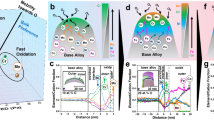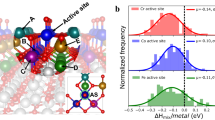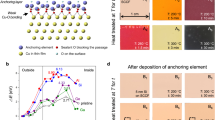Abstract
SINCE metallic oxidation is a surface phenomenon the preparation of the surface prior to the oxidation experiment is very important. If the method of preparation produces a thin film of oxide or another compound on the surface, the subsequent oxidation may be affected. Thus, Vernon, Akeroyd and Stroud1 found that the rate of oxidation of zinc below 225° C. was different for abraded, etched or electrolytically polished surfaces. For fundamental work, the ideal is to commence the oxidation with a filmfree surface. This was done in the case of iron by Davies, Evans and Agar2. The iron was reduced in hydrogen at 480° C., and after this gas had been removed by evacuation, oxygen was introduced. However, it is not possible to carry out this procedure with all metals. Thus the oxide of tin cannot be reduced by hydrogen below the melting point of the metal. The oxidation of solid tin cannot therefore be carried out on an initially film-free surface.
This is a preview of subscription content, access via your institution
Access options
Subscribe to this journal
Receive 51 print issues and online access
$199.00 per year
only $3.90 per issue
Buy this article
- Purchase on SpringerLink
- Instant access to full article PDF
Prices may be subject to local taxes which are calculated during checkout
Similar content being viewed by others
References
Vernon, W. H. J., Akeroyd, E. I., and Stroud, E. G., J. Inst. Metals, 65, 301 (1939).
Davies, D. E., Evans, U. R., and Agar, J. N., Proc. Roy. Soc., A., 225, 443 (1954).
Mills, T., and Evans, U. R., J. Chem. Soc., 2182 (1956).
Author information
Authors and Affiliations
Rights and permissions
About this article
Cite this article
DAVIES, D., SHAH, S. Cathodic Cleaning of Metals before High-Temperature Oxidation. Nature 188, 138–139 (1960). https://doi.org/10.1038/188138a0
Issue date:
DOI: https://doi.org/10.1038/188138a0



